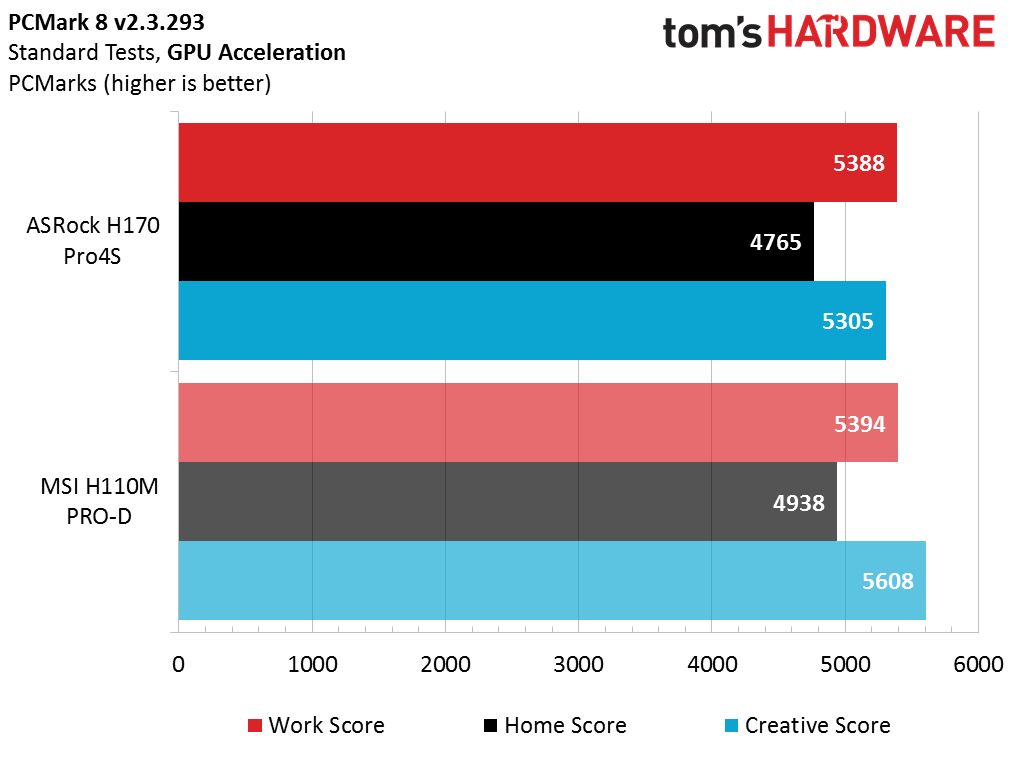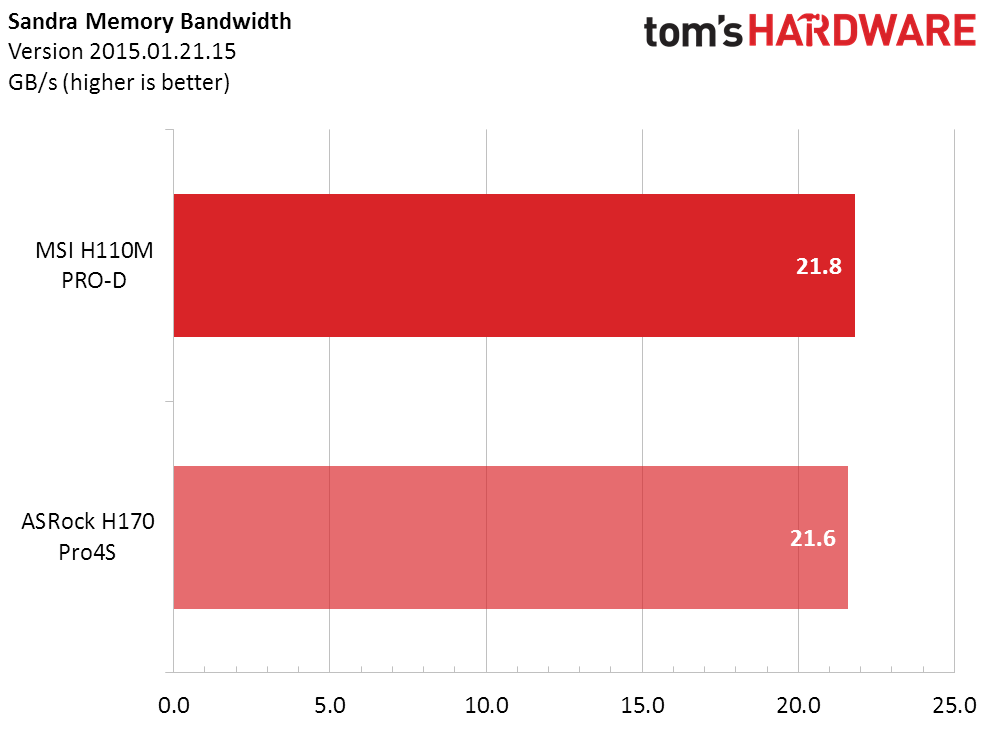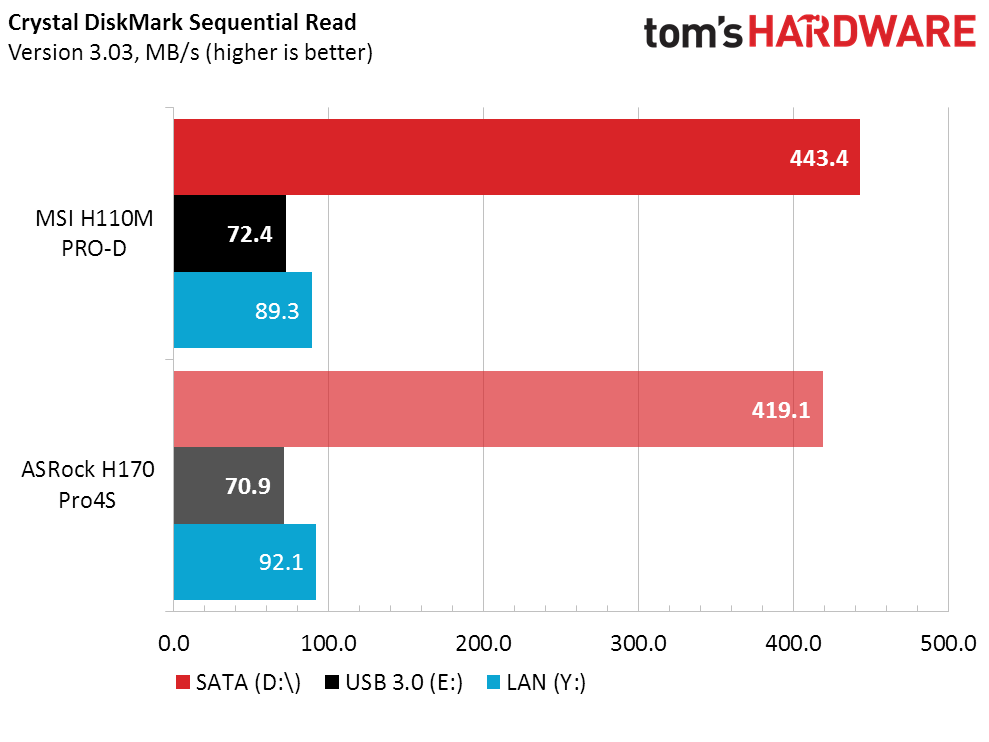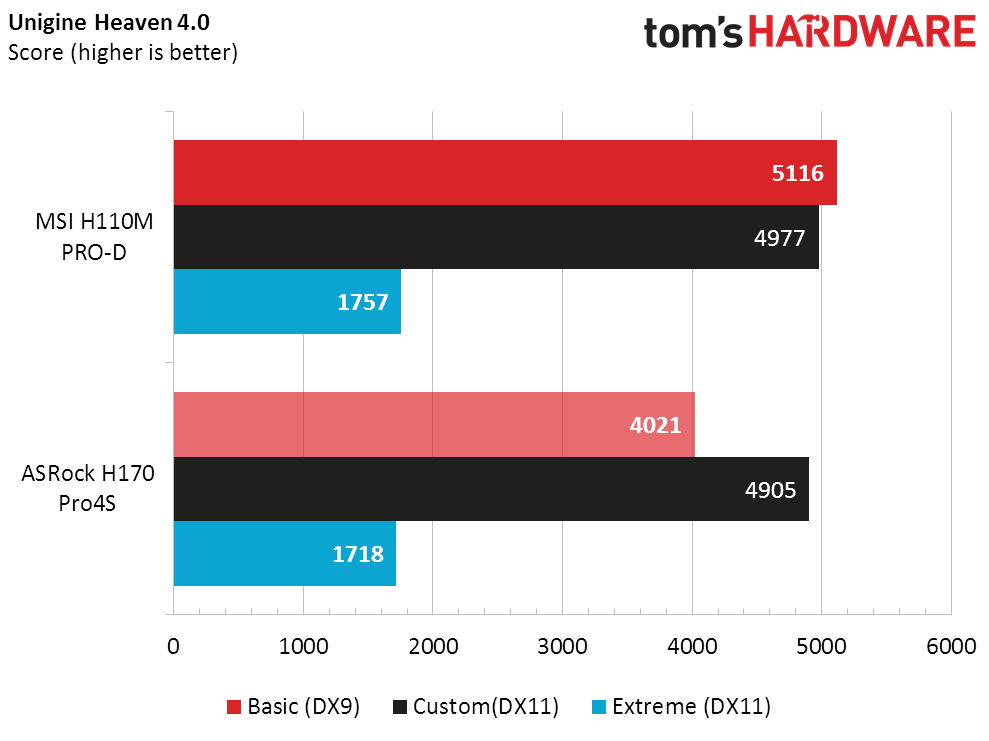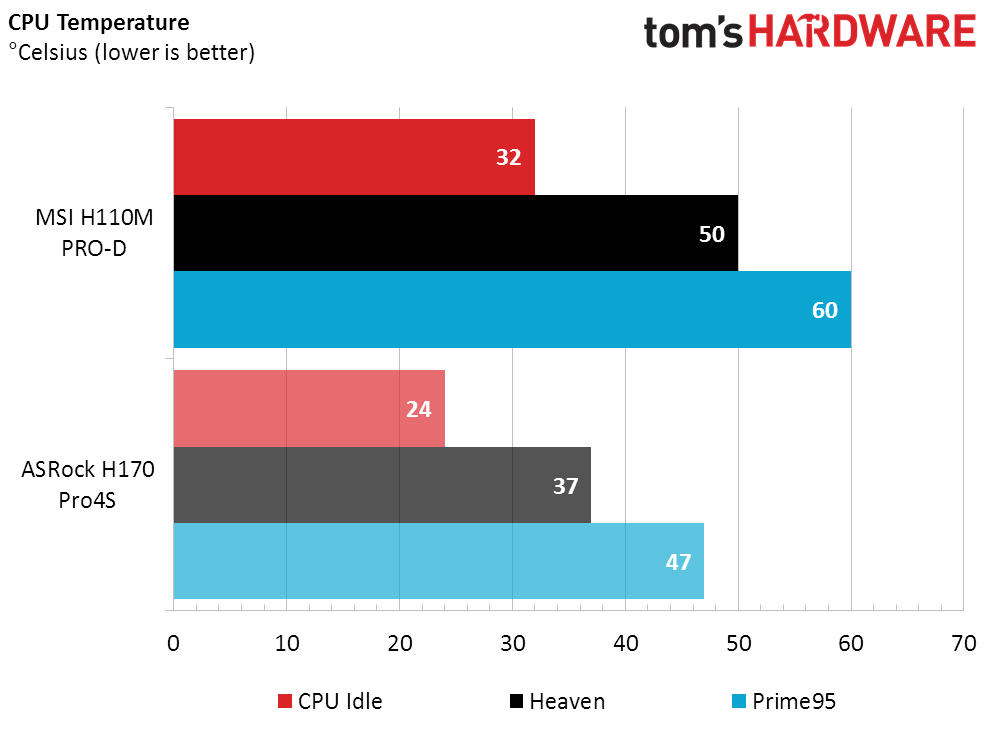MSI H110M Pro-D Motherboard Review
Why you can trust Tom's Hardware
Test Setup, Results & Final Analysis
Test Setup
The MSI H110M Pro-D and the H170 board against which it was measured were set up on an open test case. All components other than the motherboard were the same in all tests.
Benchmark Settings
| Synthetic Benchmarks and Settings | |
|---|---|
| PCMark 8 | Version: 2.5.419Work, Home, and Creative Benchmarks |
| SiSoftware Sandra | Version: 2015.01.21.15Memory Bandwidth |
| Crystal DiskMark 3.03 | 3.0.3 x64 Sequential Read |
| Unigine Heaven 4.0 | Version 4.0, Built-in BenchmarkBasic: DirectX 9, Low Detail, 1280x720, 2xAA, No TessellationCustom: DirectX11, High Quality, 1280.720, 0xAA, No TessellationExtreme: DirectX11, Ultra Quality, 1600x900, 8xAA, Highest Tessellation |
The H110 beat the H170 across the board. The differences aren’t huge, but is this what anyone would have guessed?
It’s a tiny difference, but once again the sparse H110 comes out on top.
This one is a little more interesting. The H110 wins when testing a local SATA drive and a local USB 3.0 drive, but loses when testing a LAN drive. As it turns out, there is a hardware difference there, with MSI using a Realtek LAN adapter versus an Intel controller for ASRock’s H170.
It looks like the greater the share of work done by the CPU, the better the H110 does. As the relative amount of work done by the graphics card increases, the margin of victory drops and the H110 board is able to wring more performance out of the CPU.
Once we move past performance, ASRock trounces the H110 in power consumption. The Heaven measurement is an average of the high and low readings for the Basic test, where the CPU is busiest. I really have to wonder how an ASRock H110 will do now, as a look at my past reviews shows ASRock consistently doing well on power consumption.
Although neither board reaches alarming temperatures, MSI’s H110 definitely runs hotter, consistent with its higher power usage. The difference is pretty big, but again isn’t cause for alarm.
Get Tom's Hardware's best news and in-depth reviews, straight to your inbox.
Final Thoughts
Having put my money where my mouth is, I’m happy to repeat myself: if your focus is performance, and you don’t care about tweaking, or M.2, or running multiple graphics cards, a cheap H110 board will indeed do just fine. Today’s sample in particular, the MSI H110M Pro-D, may be sparse on features, but it’s a performance winner.
MORE: Best Motherboards
MORE: How To Choose A Motherboard
MORE: All Motherboard Content
Follow us on Facebook, Google+, RSS, Twitter and YouTube.
-
jist02 I am curious about this comment:Reply
"I discovered a couple of things where defaults might not have worked. For example, on one of the screens, Win8.1/10 WHQL Support was disabled, so I turned it on."
Why do you believe this should be enabled? What does it do so that Windows 10 might not have worked without enabling it? -
DarkSable I'd love some more research into why that performance gap exists - my best theory is that the bios is more rudimentary, and so is perhaps missing power-saving features like Intel speedstep?Reply -
joex444 I've been saying the same thing. The H110 has a PCIe 3.0 x16 slot which is connected to the CPU just like Z170, so why would you expect the H110 to perform any differently? The memory controller is also on the CPU, and the same Intel SATA ports are provided just without the RAID BIOS.Reply
For the large portion of users which build a system with a locked CPU, two memory sticks, a single GPU, an SSD, and a HDD... the H110 meets those requirements. The only downside is the relative lack of USB 3.0 ports, though for most of these users their requirements are 1 keyboard, 1 mouse, and the ability to connect a flash drive or external drive. The former are handled via USB 2.0, leaving two USB 3.0 ports for devices occasionally used. -
Onus It was a GTX970; that's an error on the chart.Reply
I'm going to be looking a little more into that performance gap when I look at a couple more H110 boards in the very near future (they're on their way); in fact that's specifically why I wanted at least one more. ASRock has historically offered slightly less performance, but uses less power, so their implementation could be the opposite of what this MSI sample showed (better performance, more power used). A small clock difference might have been there too, and unfortunately I don't think I noted it.
As to the WHQL, I might be concerned that certain drivers might not load or might not be found. If I see something similar to that on another incoming board, I will try to remember to reload it twice, with the settings each way. There's a niche test I'd like to do if I can find a specific product I ordered; a programming cable used with handheld ham radios, of a type known to be problematic due to driver issues. -
Valantar This was very interesting. I'm looking forward to the follow-up!Reply
On one hand, it's not really surprising that a motherboard with no functional limitations for the relevant use cases and with fewer onboard components should perform as well, if not better than a more fully loaded alternative. After all, more onboard stuff means more work for the system, busier interconnects, and so on.
On the other hand, I wonder if there's a link between the increased power consumption and the increased performance. Might the H110 board somehow be ignoring the power limits of the CPU? Otherwise, shouldn't the power deltas between idle and Prime95 be virtually identical with identical CPUs? Prime95 stresses neither IO, RAM or PCIe, so the list of reasons for increased power consumption outside of the CPU itself is short ...
Skylake ditched the FIVR, right? So, might this board somehow be overvolting the CPU? Not that that should matter for performance unless it's running above stock clocks as well, but I can't make sense of this otherwise.
Did you by any chance log CPU frequencies during benchmark runs? -
littleleo Reply18605070 said:I am curious about this comment:
"I discovered a couple of things where defaults might not have worked. For example, on one of the screens, Win8.1/10 WHQL Support was disabled, so I turned it on."
Why do you believe this should be enabled? What does it do so that Windows 10 might not have worked without enabling it?
WHQL is the Acronym for Windows Hardware Quality Labs. Where hardware and drivers are tested for Windows compatibility. For this motherboard I believe that is to enable full UEFI support. Why it is listed like that on MSI motherboards I have no idea. -
littleleo I love this, this was a great idea, and I'm really looking forward to more comparisons based on the various chipsets. I think it could be eye opening. I wonder if the additional features the feature rich chipsets like the H170 and Z170 slows down the performance on the board? Next time perhaps instead of DX9 you can use DX12.Reply
Ideally when I am choosing a motherboard I 1st find out the CPU the customer wants to run. Then I get the list of the features the customer has to have, then the additional features he would like to have on top of that. Then I would choose the chipset has those features and look at that class of motherboard with that chipset. Then I would find the models closest to the price target of the customer. Then if there is a brand preference that should reduce the options to 1-3 models. Then the customer can choose the final model and go from there. Of course in the real world what usually happens is the guy pops in and says I have this much what can I get, lol.
-
Onus I'll take that as a complement, so thank you.Reply
Iirc, the Heaven Benchmark, even on Extreme, only went up to DX11, although might that also be a Windows 8 limitation? The whole team is moving to Windows 10 though, and adding some other updates to our testing. We each add our own flavor of course, for example using our own equipment for certain tests (e.g. the GTX970, and my LAN throughput using Igor as my target), but there is commonality to make some comparisons possible across our articles.
